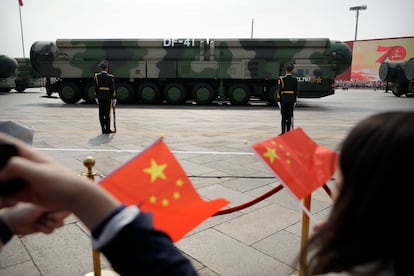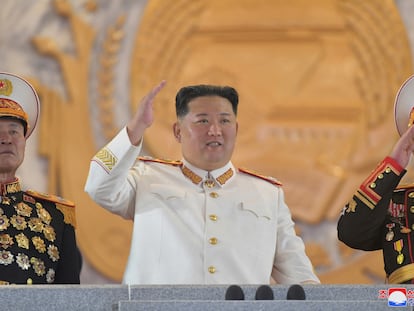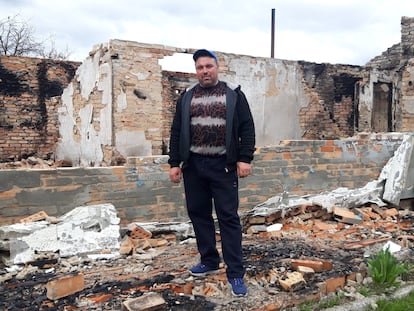Why the world faces a future with larger nuclear arsenals
Atomic powers are modernizing or expanding their stockpiles, while the post-Cold War arms control structure, which restrained the US and Russia, has crumbled

The world’s nuclear arsenal will grow throughout this decade. After more than 35 years of consistently reducing the global number of atomic weapons, experts warn that the trend will reverse in the coming years. All nuclear arsenals are being renovated or expanded; the structure of arms control and progressive disarmament, through which Washington and Moscow have dismantled tens of thousands of atomic warheads since the 1980s, is practically extinct. Moreover, the rhetoric of the leaders of some nuclear powers has grown increasingly worrisome.
According to a report by the Stockholm International Peace Research Institute (SIPRI) published this Monday, the global number of nuclear warheads decreased from 13,080 in 2021 to 12,705 this year. However, the Swedish research center’s report emphasizes that there are “clear indications” that this year-to-year reduction is probably one of the last to occur this decade. The global number of atomic weapons has been reduced by more than 80% since its peak (70,374) in 1986.
The report also underscores that the global number of operational nuclear warheads (9,440) has not declined in the last year. SIPRI estimates that the nearly 400 atomic weapons dismantled in 2021 were among the 3,000+ that Russia and the United States have already withdrawn. “All of the nuclear-armed states are increasing or upgrading their arsenals and most are sharpening nuclear rhetoric and the role nuclear weapons play in their military strategies,” said Wilfred Nan, director of SIPRI’s program on Weapons of Mass Destruction. “This is a very worrying trend.”
Russia’s nuclear arsenal remains the largest in the world; combined, Russia and the United States account for more than 90% of all nuclear warheads. For decades, the weapons that Moscow and Washington could produce and use have been limited by a series of bilateral treaties, which were signed during the so-called Golden Age of Arms Control (1987-2000). Today, only New START remains in effect (extended in extremis last year until 2026); that agreement fixes the maximum number of nuclear weapons that both countries can deploy but does not address stored weapons. Matt Korda, a researcher at SIPRI and the Federation of American Scientists (FAS), is pessimistic about the future of arms control: “It is unimaginable that Washington and Moscow are going to negotiate new limitations amidst the tremendous tensions generated by the war in Ukraine.”
The Congressional Budget Office estimates that the US will invest around $188 billion (€178 billion, a figure equivalent to Greece’s GDP) in modernizing its nuclear arsenal over the next eight years. Russia is also in the midst of expanding its nuclear capabilities by developing new warheads and delivery systems. Moreover, since the beginning of its invasion of Ukraine, the Kremlin has made various threats about using tactical nuclear weapons, a move that is unprecedented since the end of the Cold War.
Over the last decade, China has been one of the countries that has most increased its number of nuclear warheads. Its arsenal is in the midst of a period of major modernization. Last July, Beijing dazzled military analysts by reaching a milestone: China launched a hypersonic missile from a glider vehicle that also flew at more than five times the speed of sound (Mach 5). This was the most recent —and probably the most powerful— sign of the Asian giant’s evolving nuclear capabilities, causing alarm at the Pentagon. The US Department of Defense estimates that by 2030 China will increase its nuclear warheads from its current 350 to more than a thousand. Satellite images also reveal that Beijing is building more than 300 missile silos. “The United States is no longer willing to negotiate any kind of arms control agreement that does not include China,” says Korda. “And Beijing maintains that it will not accept any limits until Moscow and Washington reduce their arsenals to levels similar to [the Chinese],” he adds.
Like Russia and the US, France and the United Kingdom have fewer nuclear warheads today than they did at the end of the Cold War. In the French case, the figure is expected to remain stable, although last year Paris announced a program to develop four state-of-the-art nuclear missile submarines; between 2030 and 2040, they will progressively replace France’s current ones. For its part, in March 2021 Boris Johnson’s government reversed decades of nuclear non-proliferation, announcing that the government intends to increase its operational atomic warheads from 180 to 260.
Apart from the five UN Security Council members, the other four nuclear powers (India, Pakistan, Israel and North Korea) are also making multi-million-dollar investments in their nuclear programs. However, the official information that these countries provide about their arsenals and development plans is extremely limited, and non-existent in Israel’s case.
Since the turn of this century, India and Pakistan have steadily increased their arsenals. According to SIPRI and FAS estimates, the two traditional rivals have more than 300 nuclear weapons between them, and analysts warn of a permanent risk of conflict in the area. Last March, the Indian army accidentally launched a medium-range supersonic cruise missile against Pakistani territory. The launch did not cause any harm to people, but it did cause material damage.
Even more alarming is the North Korean nuclear program’s progress over the last five years. In its last nuclear test, in 2017, the North Korean army successfully tested a hydrogen bomb with a far greater capacity for destruction than those used in Hiroshima and Nagasaki. Since then, Kim Jong-un’s regime has displayed several intercontinental ballistic missiles and demonstrated its ability to launch from submarines. In addition, last April, Kim declared that the North Korean Armed Forces were prepared to use their nuclear weapons “at any time” and urged the atomic program to advance “at an even faster pace.”
The nuclear powers are not just working on their atomic development programs. Negotiations to revive the nuclear deal with Iran — which former US President Donald Trump unilaterally broke in 2018 — remain in limbo. Meanwhile, earlier this month the International Atomic Energy Agency warned that “within a few weeks” Tehran will possess enough enriched uranium to produce an atomic bomb. Last Wednesday, the Islamic Republic disconnected 27 surveillance cameras from its nuclear facilities. Saudi Arabia and Turkey have threatened to launch nuclear programs in response to Iran’s activities.
The SIPRI report also highlights a couple of positive developments for non-proliferation. The Treaty on the Prohibition of Nuclear Weapons went into effect in January 2021 after 50 UN members ratified it. However, the treaty has not been signed by any nuclear power or NATO member. And earlier this year, the five members of the Security Council issued a remarkable statement saying that “a nuclear war cannot be won and [one] should never be started.”
Tu suscripción se está usando en otro dispositivo
¿Quieres añadir otro usuario a tu suscripción?
Si continúas leyendo en este dispositivo, no se podrá leer en el otro.
FlechaTu suscripción se está usando en otro dispositivo y solo puedes acceder a EL PAÍS desde un dispositivo a la vez.
Si quieres compartir tu cuenta, cambia tu suscripción a la modalidad Premium, así podrás añadir otro usuario. Cada uno accederá con su propia cuenta de email, lo que os permitirá personalizar vuestra experiencia en EL PAÍS.
¿Tienes una suscripción de empresa? Accede aquí para contratar más cuentas.
En el caso de no saber quién está usando tu cuenta, te recomendamos cambiar tu contraseña aquí.
Si decides continuar compartiendo tu cuenta, este mensaje se mostrará en tu dispositivo y en el de la otra persona que está usando tu cuenta de forma indefinida, afectando a tu experiencia de lectura. Puedes consultar aquí los términos y condiciones de la suscripción digital.











































